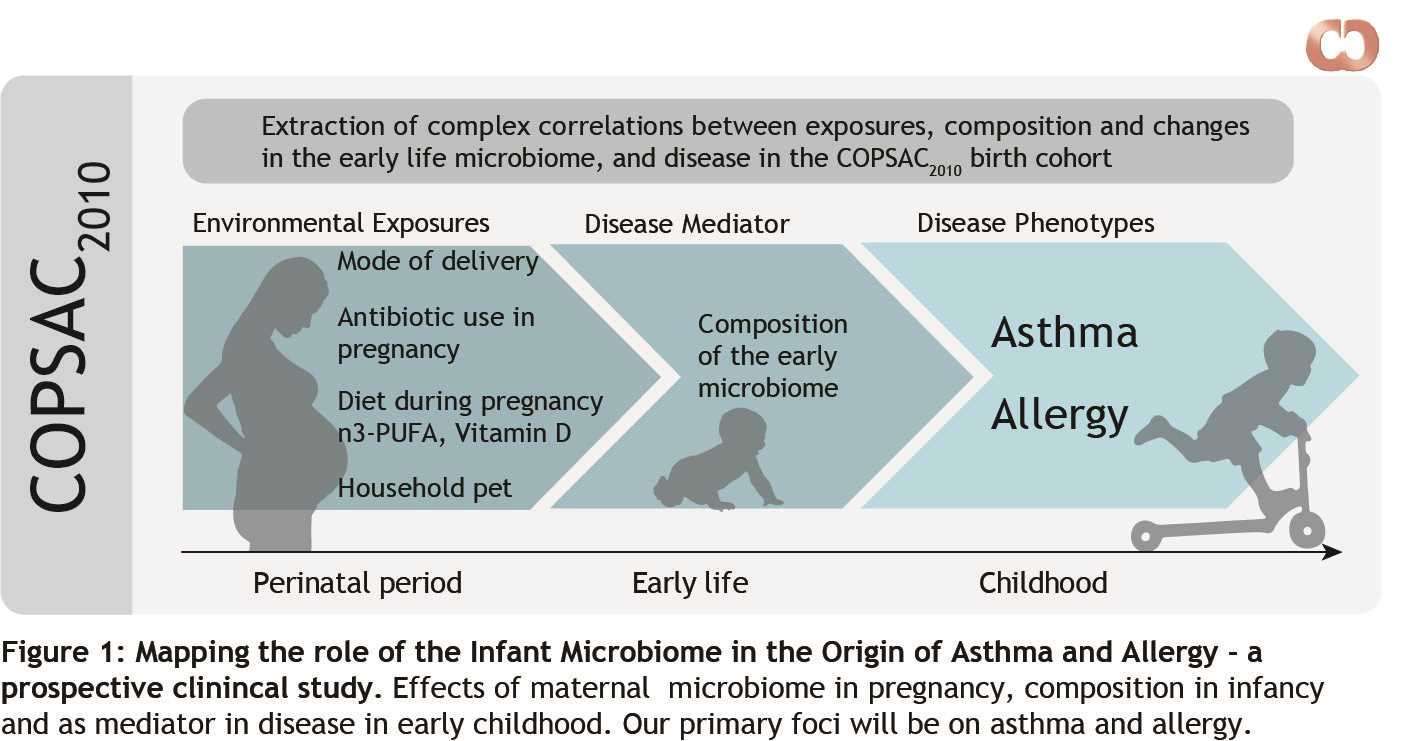 Mapping the role of the microbiome in the origin of asthma and allergy, a prospective clinical study
Mapping the role of the microbiome in the origin of asthma and allergy, a prospective clinical study
Our ambition in this project is to substantiate the correlation between environmental exposures, the early life microbiome and later disease development focusing on asthma and allergy. The novelty in this project lies in the internationally unique longitudinal analysis of the early microbiome sampled from several compartments from pregnancy and onwards since 1 week of age in 700 children.
The overall aim of this translational project is to explore the association between alterations in the microbiome, in different body compartments, and the development of asthma and allergy in childhood.
Background and aim
Asthma and allergy are the most common chronic diseases in children in westernized countries and their incidences have more than doubled in the last decades, now affecting about 20% of all pre-school children. Early life is a critical period for environmental exposures to imprint lasting effects on the developing immune system through complex gene-environment interactions. In recent years our microbial environment has come into attention as one mediator of such effects. The Copenhagen Prospective Studies on Asthma in Childhood (COPSAC)has in ground breaking studies been focusing strongly on the role of the human microbiome in the development of chronic disease. In this project we wish to pursue the clinical assessments and the data collection in the COPSAC2010 cohort to include children at school age to complete our ongoing characterization of the human microbiome in pregnant women and their children over time.
The overall aim of this translational project is to explore the association between alterations in the microbiome, in different body compartments, and the development of asthma and allergy in childhood.
Perspectives
The perspectives of this project is that manipulation of an inadequate human microbiome in early-life may prevent chronic inflammatory diseases such as asthma and allergy. The perspectives of defining a potential beneficial microbial composition could lay the ground for the development of a testable model and of innovative preventive 'next-generation probiotic' interventions. If successful, this strategy could lead to novel prevention strategies and targeted, efficient microbiota manipulation in groups at risk of developing disease due to microbiota dysbiosis.
Project owner
Professor Hans Bisgaard
Head of Copenhagen Propective Studies on Asthma in Childhood (COPSAC), DSI Dansk BørneAstma Center, Gentofte Hospital.
Partners
DSI Dansk BørneAstma Center, COPSAC
 Professor Søren Sørensen
Professor Søren Sørensen
I am currently team leader for a group of 12 scientists, 11 phd’s, three technicians and ten master students applying molecular techniques in microbial ecological studies at the Section of Microbiology. My research focuses on social interactions in microbial populations. My group’s studies evaluate the extent of genetic flow within natural communities and their response to environmental perturbations.
The section houses state of the art culture independent experimental infrastructure that enables us to examine how microbes interact at a scale that is relevant for such small organisms and to examine and identify the roles of the individual species that contribute to these interactions.
We investigate how microbes work together in in their natural state such as biofilms and the effect this has on microbial communities in in vivo systems such as human or animal gut, soil, or phase change communities. These are related to our in vitro model systems such as our bioflux biofilm system where we can evaluate our findings and examine phenomenon such as horizontal gene transfer or emergent community properties and evolutionary strategies. To do so we use techniques such as high throughput sequencing, flow cytometry and ultra-high resolution bioimaging or confocal microscopy and microbial reporter systems.
The pioneering work of the section has had been recognized for its impact in diverse areas in which microbial interactions are critical. These include, Soil biodiversity and bioremediation, the role of horizontal gene transfer, human disease progression, the effects of species diversity in plant animal and environmental microbiomes, how microbes interact in evolutionary strategies and the significance of cooperation verses antagonism in microbial systems.
Working in these areas necessitates close collaboration with international scientists from around the world that come to the section and to whom members of the section visit in scientific exchange programs. They span all corners of the globe including Dr. Duncan Veal, Macquarie University, Sydney Australia, Prof A. Spormann, Stanford University, Prof. S. Kjelleberg, University of NSW; Prof. M. Schloter, Helmholtz Zentrum München; and Prof. Md Hans Bisgaard COPSAC back here in Denmark.
These collaborations have helped more than 20 postdocs and 30 past Ph.D. fellows follow their career path both here and around the world to obtain successful positions in both academia and research.
Section of Microbiology

Funded by:
Lundbeck grant for the project:
Project title: Mapping the role of the microbiome in the origin of asthma and allergy, a prospective clinical study
Project period: 01.01.2017 - 30.06.2020
Contact
 Professor
Professor
Søren J. Sørensen
Universitetsparken 15
Building 1, 1st floor
DK-2100 Copenhagen


